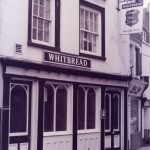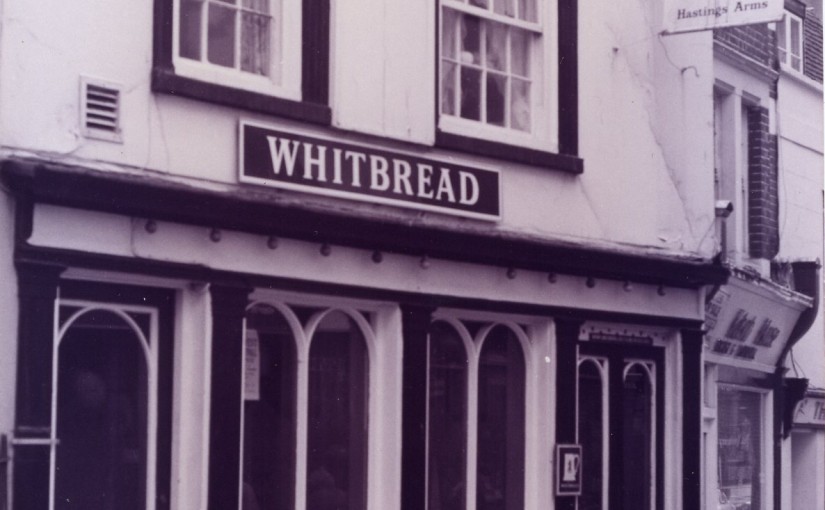By John Hodges
At some time in the seventeenth century Hastings began to expand out of the valley of the Bourne , and odd buildings were erected in an area to the West that became known as the “Suburbs”. It was not until 1811 that this newly developed street became known locally as George Street, and early in the nineteenth century the George Inn was opened. This was not the same George Inn upon which the Kings Head was subsequently built, but an inn that was owned by Edward Milward and was sold in 1827, and at this point it was likely that it ceased trading as a pub and its name transferred to the George Inn in All Saints Street. The Hastings Arms, because of its position at the Eastern end of George Street, opened sometime before this street was designated. We know that a John Sargent living at an address that corresponds with today’s Hastings Arms at around 1786, but it did not receive its current name until 1794. There is no doubt that despite many counter claims this public house is one of the very oldest in Hastings.

There were several other hostelries that have come and gone within the immediate vicinity of George Street, recorded among them were, The Ancient Druids, Albion Shades, The Grapes, The Market Tap, The Red Harte, The Market Tavern in East Parade, and The Rose and Crown that was demolished to accommodate the building of the Market Hall. One of the original reasons why public houses were recorded so assiduously was for their other purpose as designated billets for troops around the country. Hastings was no exception, especially during the period when Napoleonic invasion threatened, and The Hastings Arms was certainly one such public house recorded as providing accommodation for the military. In fact military tradition became so imbued within its character that at the conclusion of the Napoleonic Wars, peace was celebrated with the erection of an illuminated sign depicting the final fall of the bellicose Corsican.
The status of The Hastings Arms was further developed when in 1822 a lodge of the Grand Order of Druids was opened on the premises. The Druids were a somewhat different sort of society from the many other friendly societies that came into being around this time. They were founded in 1781 at the Old King’s Arms Tavern in Poland Street, London, at a time when eighteenth-century British intellectuals were very interested in the Druids. They were attracted to the idea that ancient Britain had not been populated by savages but had an order of learning and wisdom that had rivaled, and possibly influenced, the Greek philosophers and the astrologers of ancient Persia. It was also believed that the Druids had believed in one all-powerful God and a prophesied Redeemer. To the eighteenth-century mind this made them virtually proto-Christians, and therefore their rituals, or what were thought to be their rituals, could be revived and performed without any taint of paganism. The more mundane and practical reasons for the growth in this sort of movement was spurred by the Industrial Revolution, the lack of Trade Unions, and the lack of personal or public insurance. Only by joining mutual friendly societies like the Druids could ordinary people protect themselves and their families against the financial implications brought on them through illness, injury or even death.
From 1827, and for a further eighteen years, the landlord of The Hastings Arms was one Richard Harman. Described as an election agent, and a promoter of the infamous Rock Fair held for many years on a site near the White Rock, but at this time on some level ground near the old Priory Bridge. This landlord was also described as a “wrecker”, which loosely meant one engaged in the practice of taking valuables from a ship wreck which had foundered close to shore. Often an unregulated activity of opportunity in coastal communities, wrecking has been subjected to increasing regulation and evolved into what is now known as marine salvage. Wrecking is no longer economically significant; however, as recently as the 19th century in some parts of the world, it was the mainstay of otherwise economically marginal coastal communities. Harman was also deeply involved in 1837 with Joseph Planta the local Tory MP with all sorts of activities that were aimed at securing Planta’s re-election to the seat that he had lost in 1832, but many of these schemes that would be described today as electoral irregularities, would most certainly not stand a closer inspection.
The rear section of the public house was at one time known as the Hastings Arms Shades, and although the floor area could support this sort of sub division there is no evidence that it ever supported an on-site brewery. Even as early as 1790 there were several local brewers in the Old Town of Hastings, who could take water from their own wells. But it was the demise of the Bourne Stream as a supply of clean water that probably did more to influence local innkeepers to look to the large brewers with ready access to wells for their supply of ale, than anything else. The Hastings Arms was never one of the houses in the tied estate of Thomas Breeds & Co., as were so many in this part of Old Hastings. It did however, for a short time, form part of the assets of the Hastings Bank of which Thomas Breeds was a director, but upon the dissolution of the owning partnership, The Hastings Arms was allocated to Edward Wenham as part of his share of the Bank’s assets. The first brewer to whom we know that the pub was tied appears to be Alfred Leney & Co.Ltd. of The Phoenix Brewery, Dolphin Lane, Dover. Quite when this property was acquired by Leneys is unclear, but when they registered as a limited company in 1897 they already owned over one hundred licensed premises. What is certain is that they owned a number of public houses in the Town which were all serviced from a stores and office complex at the western end of George Street. The Hastings Arms traded in the colours of Alfred Leney through until 1926, and despite a period of acquisition by the Dover based brewery the operation was leased by Fremlins, and in 1927 brewing ceased although it continued as a bottling plant for Fremlins until 1950. In 1962 Fremlins , by then part of the giant Whitbread’s group, purchased the Leney’s tied estate outright and all operations ceased in Dover, with the old brewery buildings being demolished in 1965.
As part of the Lord Young’s rationalisation of the British brewing industry, Whitbread for a period resorted to its origins as a brewer, while its huge tied estate was divested in others. The Hastings Arms along with eight other public houses in the Hastings area were leased from 1992 to the Faversham brewer Shepherd Neame, as part of their strategy of becoming the most substantial of the regional brewers. This relationship with Shepherd Neame still flourishes to this day, while the Hastings Arms continues as a most welcoming of hostelries serving not only good Kentish Ales, but an excellent range of quality home- made food. All of this is a far cry from the days when the military waited in the same bar, marking time for the arrival of a threatened invasion that never came. Now the only invasion is one by delighted tourists, who join the locals in this excellent and unspoilt public house that can boast an existence of at least two and a quarter centuries.
“Hastings Town” October 2015
All articles, photographs, films and drawings on this web site are World Copyright Protected. No reproduction for publication without prior arrangement. (Hard Copy Back Numbers Still Available) © World Copyright 2015 Cinque Ports Magazines Rye Ltd., Guinea Hall Lodge Sellindge TN25 6EG
